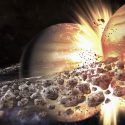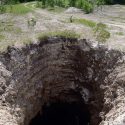What Earth do you live on? A round one? Flat one? Maybe your world is resting on the back of a huge cosmic turtle? What about a hollow Earth? Just a planet’s shell levitating around absolutely nothing.
How would the laws of physics work on that hollow Earth? Would we be able to dig a hole all the way to its center? And if we did, what would being in that center feel like? Here’s what would happen if the Earth was hollow.
We’ve never made the journey to the Earth’s core, but we have been studying earthquakes and our geomagnetic field enough to know what’s inside our planet. Spoiler alert – it’s dense and boiling hot. But we didn’t always know that. Learning about how our world works took a lot of time, and brought out some bizarre theories.
One scientist even decided that the Earth was an inverted sphere, with the entire Universe hidden inside. Hollow Earth was also on the list of possibilities. But how would a planet like that work?
The quick answer is – it wouldn’t. A hollow Earth would collapse inwards on itself and become a smaller sphere. Why? Because of gravity, one of the four fundamental forces in the Universe. Gravity would bring all parts of the crust toward one another, making the hollow Earth just impossible. But where’s the fun in that?
Let’s assume, somehow the Earth’s crust could levitate without collapsing on itself. Well, that wouldn’t be much fun for us either. Most likely, there would be absolutely no life on the planet. Because, for starters, there would be no atmosphere.
The atmosphere of the Earth protects us from solar winds and space radiation. But it needs a magnetic field and the planet’s gravity to keep it in place. The magnetic field is generated in the Earth’s core, which would be absent in a hollow planet. No core means no magnetic field, and no magnetic field means that the Earth would be pretty dead.
A hollow Earth would also lose a whole lot of mass, since most of it is accumulated in the planet’s inner part – the core and the mantle. We’re not just talking a few kilos, like what you put on during your last visit to Grandma’s, but rather 5.9 sextillion tonnes. A hollow Earth would be less than 0.4% of its current mass.
The gravity on a hollow Earth would be so weak, it wouldn’t be enough for you to stick to the planet. You’d fly away into space. That’s, of course, if you could make it through all the solar radiation.
Now let’s imagine that the hollow Earth’s mass and gravity were no different from a real-life Earth. We’d still have no atmosphere due to the lack of a geomagnetic field, but at least we’d solve the gravity problem so that you could stay on the planet.
The surface of that hollow Earth would be a very hostile place. But with no core of boiling iron, would you be able to move under the planet’s crust? Drilling through the Earth’s crust would be much harder, as it would have to be formed from a very dense material to make up such a mass.
When you finally managed to dig through the 30-km thick crust (18-mile), and stepped into the interior of the planet, you’d experience zero-gravity. Since any gravity in a hollow Earth would have to be coming from the crust, gravity would just cancel itself out, and it’s influence on you would be zero.
You’d be floating back and forth in a complete darkness, forever lost inside an empty planet. Don’t forget your spacesuit. You’ll need it to provide oxygen, and pressure to keep breathing – until you run out of said oxygen. Drifting inside the Earth without a spacesuit would be like stepping into the vacuum of space.
Trust me, you don’t want to experience that. And next time you feel empty inside – remember that the Earth you’re sitting on isn’t. Maybe in the future we’ll travel beyond Earth and stumble across the planet that is hollow.
[/expand]



























